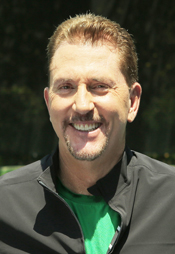Your Strokes:
Ryan Serve
John Yandell
This month we look at junior player Ryan's serve from some excellent video sent in by his coach Ramiro. They are based in Texas, and Ramiro tells me he has been a subscriber since 2005 and in part used Tennisplayer video in developing Ryan's serve.
He did a great job! I don't see any big flaws in the motion. But I do have some suggestions on how they might further improve it, using my favorite serve model Roger Federer.
So let's go through Ryan's strong fundamental elements and then progress from there. Let's start with the racket path.
Racket Path
Ryan has a smooth, slightly abbreviated windup. As we have seen many times the exact shape of the windup varies from player to player.
But all effective windups deliver the arm and racket to the trophy position at the right moment. Ryan's timing on this looks perfect.
Could the racket face be slightly more on edge, a little more perpendicular to the net? Possibly. That might increase the amount of backward or external shoulder rotation as he moves into the racket drop. But that might also be related to shoulder flexibility.
The other key point here is that the timing of the entry into the drop. The great Brian Gordon has established that the entry into the racket drop should correlate with the start of the push with the legs upward.
The push of the legs has the effect of increasing the backward or external rotation of the hitting shoulder. Ryan's motion checks that box perfectly. Watch how the move into the drop starts exactly when you see his knee bend starting to explode upward.
The racket drop itself is quite good with the racket falling along his right side and the tip of the racket pointing basically straight down at the court. Could it be a little deeper?
Maybe and that could relate to the position of the edge of the racket at the trophy position or, again, his natural shoulder flexibility. If you compare him to Federer, you can see Roger's forearm is parallel to the court surface and his drop is deeper.
Ryan's is just shy of that. So if it was slightly lower that would possibly increase the backward or external rotation of the arm in the shoulder joint. Again nothing technically wrong here, just a question of whether it could be slightly better.
Upward Swing
Ryan's upward swing to the ball looks great. He makes contact just at the front edge of the body.
Also note his torso position is slightly closed to the baseline. That's the right rotation timing.
The racket head is tilted back to his left by a few degrees. This shows his ball position on the toss was great. It's the proof that there is a topspin component in his ball.
His hand, arm and racket rotation is also great. This is driven by internal shoulder rotation. Everything turns over together after contact, with the racket face square to the court.
And that happens fast. The rotation is complete before the hand gets down to even head level. This is a great indication of racket speed. His position matches Federer virtually perfectly here.
The arm then relaxes and falls naturally to his left side. He then lands on balance on the front foot just inside the baseline with the rear leg kicking back.
Stance Improvements?
You could work a long while to develop as good a technical motion as Ryan and his coach Ramiro have developed. But again using the Federer model I see one relatively easy change that could make a difference. This would be would I suggest trying first.
It has to do with the starting stance and the body rotation away from the ball in the start of the motion. The more backward rotation in the wind up, the more forward rotation in the delivery.
And these rotations are largely a function of stance. Ryan has an offset stance with his right front toe basically aligned with his left foot heel.
But the feet are quite close together. And this spacing limits his turn away from the ball.
Compare that to Roger whose back foot is offset and back a couple of feet—maybe shoulder width behind the front.
When the motion begins, Roger's body turns away along a line drawn across the toes of the feet. So his torso turns back away from the ball 30 to maybe 45 degrees.
Ryan's turn is much less. If he adjusted his starting stance to the Federer model, he'd get the same turn automatically.
So that's the experiment I am suggesting for him and Ramiro. More body rotation I think means more racket speed, more ball speed, and possibly more spin. And also, possibly more disguise.
Like I said at the start, it's a really good looking motion. If they follow the stance idea and maybe some of the others suggestions, I'll be really interested in hearing about—and seeing video of—what that does for his serve!




